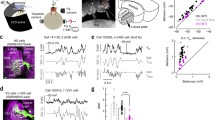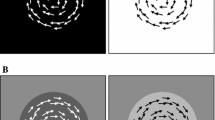Abstract
A fly can discriminate an object (“figure”) from its background on the basis of motion information alone. This information processing task has been analysed, so far, mainly in behavioural studies but also in electrophysiological experiments (Reichardt et al., 1983). The present study represents a further attempt to bridge the gap between the behavioural and the neuronal level. It is based on behavioural and electrophysiological experiments as well as on computer simulations. The characteristic properties of figureground discrimination behaviour impose specific constraints on the spatial integration properties of the output cells of the underlying neuronal network, the heterolateral interactions in their input circuitry, as well as on the range of variability of their response. These constraints are derived partly from previous behavioural studies (Reichardt et al., 1983), partly, however, from behavioural response characteristics which have not been addressed explicitly so far. They are interpreted in terms of one of the alternative model circuits shown by Reichardt et al. (1983) to be sufficient to account for figure-ground discrimination. It will be demonstrated, however, that this can be done equally well by means of a further alternative model circuit. These constraints are used in the electrophysiological analysis for establishing visual interneurones as output elements of the neuronal network underlying figure-ground discrimination.
In the behavioural experiments on figure-ground discrimination as well as on the optomotor course control the yaw torque generated by the tethered flying fly under visual stimulation was used as a measure for the strength and time course of the reaction. Therefore, it has initially been proposed that the three Horizontal Cells, which are regarded as the output elements of the neuronal network underlying the optomotor reaction (e.g. Hausen, 1981), might also control yaw torque generation in figure-ground discrimination (Reichardt et al., 1983). New behavioural data show, however, that the Horizontal Cells do not meet all the constraints imposed on the presumed output cells of the figure-ground discrimination network: (1) The Horizontal Cells are not sensitive enough to motion of small objects. (2) The heterolateral interactions within their input circuitry are not in accordance with the behavioural data (see also Reichardt et al., 1983). (3) The variability found in the time course of certain components of the yaw torque response to relative motion of figure and ground cannot be explained by their response characteristics. Hence, the Horizontal Cells cannot account for figure-ground discrimination on their own and additional output cells of the optic lobes with different functional properties are required to accomplish this task.
Similar content being viewed by others
References
Baker, C.L., braddick, O.J.: Does segregation of differently moving areas depend on relative or absolute displacement. Vision Res. 22, 851–856 (1982)
Bausenwein, B.: Eigenschaften der Objektreaktion von Drosophila melanogaster. Diplomarbeit, Universität Würzburg (1984)
Bülthoff, H.: Figure-ground discrimination in the visual system of Drosophila melanogaster. Biol. Cybern. 41, 139–145 (1981)
Case, R.: Differentiation of the effects of pH and CO2 on the spiracular functions of insects. J. Cell Physiol. 49, 103–133 (1957)
Collett, T.S.: Angular tracking and the optomotor response. An analysis of visual reflex interaction in a hoverfly. J. Comp. Physiol. 140, 145–158 (1980)
Doorn, A.J. van, Koenderink, J.J.: Visibility of movement gradients. Biol. Cybern. 44, 167–175 (1982)
Egelhaaf, M.: On the neuronal basis of figure-ground discrimination by relative motion in the visual system of the fly. Part II. Figure-Detection Cells, a new class of visual interneurones. Biol. Cybern. (in press, 1985a)
Egelhaaf, M.: On the neuronal basis of figure-ground discrimination by relative motion in the visual system of the fly. Part III. Possible input circuitries and behavioural significance of the FD-cells. Biol. Cybern. (in press, 1985b)
Fermi, G., Reichardt, W.: Optomotorische Reaktionen der Fliege Musca domestica. Abhängigkeit der Reaktion von der Wellenlänge, der Geschwindigkeit, dem Kontrast und der mittleren Leuchtdichte bewegter periodischer Muster. Kybernetik 2, 15–28 (1963)
Franceschini, N., Kirschfeld, K.: Les phénomènes de pseudopupille dans l'oeil composé de Drosophila. Kybernetik 9, 159–182 (1971)
Geiger, G., Nässel, D.R.: Visual orientation behaviour of flies after selective laser beam ablation of interneurones. Nature 293, 398–399 (1981)
Geiger, G., Nässel, D.R.: Visual processing of moving single objects and wide-field patterns in flies: Behavioural analysis after laser-surgical removal of interneurons. Biol. Cybern. 44, 141–149 (1982)
Götz, K.G.: Optomotorische Untersuchung des visuellen Systems einiger Augenmutanten der Fruchtfliege Drosophila. Kybernetik 2, 77–92 (1964)
Götz, K.G.: Flight control in Drosophila by visual perception of motion. Kybernetik 4, 199–208 (1968)
Götz, K.G.: Genetischer Abbau der visuellen Orientierung bei Drosophila. Verh. Dtsch. Zool Ges. 76, 83–99 (1983)
Harmon, L.D.: Neural subsystems: An interpretive summary. In: The neurosciences; second study program. pp. 486–494. Schmitt, F.O., ed. New York: Rockefeller University Press 1970
Hausen, K.: Struktur, Funktion und Konnektivität bewegungsempfindlicher Interneurone im dritten optischen Neuropil der Schmeißfliege Calliphora erythrocephala. Doctoral Dissertation, Universität Tübingen (1976)
Hausen, K.: Monocular and binocular computation of motion in the lobula plate of the fly. Verh. Dtsch. Zool. Ges. 74, 49–70 (1981)
Hausen, K.: Motion sensitive interneurons in the optomotor system of the fly. I. The Horizontal Cells: structure and signals. Biol. Cybern. 45, 143–156 (1982a)
Hausen, K.: Motion sensitive interneurons in the optomotor system of the fly. II. The Horizontal Cells: receptive field organization and response characteristics. Biol. Cybern. 46, 67–79 (1982b)
Hausen, K.: The lobula-complex of the fly: Structure, function, and significance in visual behaviour. In: Photoreception and vision in invertebrates. pp. 523–559. Ali, M. ed. New York, London: Plenum Press 1984
Hausen, K., Wehrhahn, C.: Microsurgical lesion of horizontal cells changes optomotor yaw responses in the blowfly Calliphora erythrocephala. Proc. R. Soc. London Ser. B 219, 211–216 (1983)
Heisenberg, M., Wolf, R.: Vision in Drosophila. Berlin, Heidelberg, New York: Springer 1984
Heisenberg, M., Wonneberger, R., Wolf, R.: OptomotorblindH-31 — a Drosophila mutant of the lobula plate giant neurons. J. Comp. Physiol. 124, 287–296 (1978)
Hengstenberg, R.: Zeitstrukturen der spontanen Flugaktivität von Calliphora. Verh. Dtsch. Zool. Ges. 76, 246 (1983)
Hildreth, E.C.: The computation of the velocity field. Proc. R. Soc. London Ser. B 221, 189–220 (1984)
Julesz, B.: Foundations of cyclopean perception. Chicago: University of Chicago Press 1971
Levick, W.R.: Another tungsten microelectrode. Med. Biol. Eng. 10, 510–515 (1972)
Marr, D.: Vision, San Francisco: Freeman 1982
McCann, G.D., MacGinitie, G.F.: Optomotor response studies of insect vision. Proc. R. Soc. London Ser. B 163, 369–401 (1965)
Poggio, T., Reichardt, W.: Visual control of orientation behaviour in the fly. Part II. Towards the underlying neural interactions. Q. Rev. Biophys. 9, 377–438 (1976)
Poggio, T., Reichardt, W., Hausen, K.: A neuronal circuitry for relative movement discrimination by the visual system of a fly. Naturwissenschaften 68, 443–446 (1981)
Rall, W.: Core conductor theory and cable properties of neurons. In: Handbook of Physiology. Vol. I, pp. 39–97, Kandel, E.R., Geiger, S.R., eds. Bethesda, Maryland: American Physiological Society 1977
Regan, D., Beverley, K.I.: Figure-ground segregation by motion contrast and by luminance contrast. J. Opt. Soc. Am. A1, 433–442 (1984)
Reichardt, W.: Musterinduzierte Flugorientierung. Verhaltensversuche an der Fliege Musca domestica. Naturwissenschaften 60, 122–138 (1973)
Reichardt, W., Poggio, T.: Visual control of orientation behaviour in the fly. Part I. A quantitative analysis. Q. Rev. Biophys. 9, 311–375 (1976)
Reichardt, W., Poggio, T.: Figure-ground discrimination by relative movement in the visual system of the fly. Part I. Experimental results. Biol. Cybern. 35, 81–100 (1979)
Reichardt, W., Poggio, T., Hausen, K.: Figure-ground discrimination by relative movement in the visual system of the fly. Part II. Towards the neuronal circuitry. Biol. Cybern. 46 (Suppl.), 1–30 (1983)
Strausfeld, N.J.: Atlas of an insect brain. Berlin, Heidelberg, New York: Springer 1976
Virsik, R., Reichardt, W.: Tracking of moving objects by the fly Musca domestica. Naturwissenschaften 61, 132–133 (1974)
Virsik, R., Reichardt, W.: Detection and tracking of moving objects by the fly Musca domestica. Biol. Cybern. 23, 83–98 (1976)
Wagner, H.: Flight performance and visual control of flight of the free flying housefly (Musca domestica) Doctoral Dissertation, Universität Tübingen (1985)
Author information
Authors and Affiliations
Rights and permissions
About this article
Cite this article
Egelhaaf, M. On the neuronal basis of figure-ground discrimination by relative motion in the visual system of the fly. Biol. Cybern. 52, 123–140 (1985). https://doi.org/10.1007/BF00364003
Received:
Issue Date:
DOI: https://doi.org/10.1007/BF00364003




